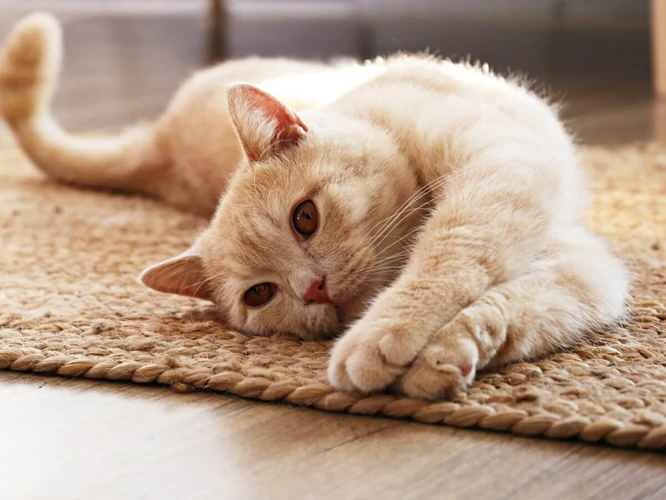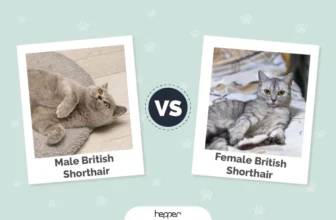As a proud owner of an American Shorthair, you may have noticed your furry friend marking their territory indoors. This behavior can be frustrating and even lead to conflicts within your household. While it may seem like an impossible task, discouraging your American Shorthair from marking indoors is definitely achievable. In this informative and practical article, we will explore the key reasons behind why American Shorthairs mark indoors and provide effective tips and training methods to discourage this behavior in a humane and effective manner. So put away those cleaning supplies and get ready to learn how to enjoy a harmonious and clean environment with your American Shorthair!
Why Do American Shorthairs Mark Indoors?

It can be quite perplexing and frustrating to discover that your American Shorthair has been marking their territory indoors. This behavior is not only unpleasant and smelly but also damages your furniture and floors. Understanding the reasons behind this behavior is the first step in addressing it effectively. Let’s dive into some possible reasons why your American Shorthair might be marking indoors, including natural instincts, medical conditions, and behavioral issues. To prevent any more damage, you can use positive reinforcement by redirecting their behavior and following some essential tips. So, let’s get started!
Natural Instincts
American Shorthairs are known for their natural instincts to mark their territory. It’s a way for them to claim their space and establish dominance. This behavior is commonly seen in male American Shorthairs who have not been neutered, but females can also display territorial marking behavior.
What are the natural instincts of American Shorthairs that cause marking behavior?
- Scratching: American Shorthairs use scratching as a way to mark their territory. They have scent glands in their paws that leave a scent behind, marking the area as their own.
- Spraying: Male American Shorthairs who have not been neutered, can spray to mark their territory. The strong smell of the spray is difficult to remove and can cause damage to the area.
- Rubbing: American Shorthairs rub their scent on objects or people to mark them as their own.
It’s important to understand that these natural instincts are not always a sign of a behavioral issue. However, if the marking behavior is excessive, it can be alarming and frustrating for pet owners. If your American Shorthair is marking inside, it’s important to rule out any underlying medical conditions that could be causing the problem. If there are no medical issues, then modifying the behavior through training and environmental changes can be effective in stopping the behavior.
If you want to prevent and stop your American Shorthair from marking indoors, follow our tips and be consistent in implementing them.
Medical Conditions
Cats may also mark indoors due to medical conditions. If your American Shorthair suddenly starts to mark their territory inside the house, it may be a sign of an underlying health issue. Some possible medical causes of marking include urinary tract infections, bladder stones, and kidney disease. These conditions can cause your cat to urinate more frequently and in inappropriate areas.
Table of Medical Conditions That Can Cause Marking in American Shorthairs
| Medical Condition | Symptoms |
|---|---|
| Urinary tract infections (UTIs) | Frequent urination, straining to urinate, crying out when urinating, blood in urine, licking genital area excessively, and decreased appetite |
| Bladder stones | Frequent urination, crying out when urinating, blood in urine, licking genital area excessively, and decreased appetite |
| Kidney Disease | Increased thirst and urination, vomiting, diarrhea, weight loss, bad breath, and decreased appetite |
If you suspect that your American Shorthair is marking due to a medical condition, it is important to take them to the vet for a check-up. Your vet may perform diagnostic tests such as blood work, a urinalysis, or an ultrasound to rule out underlying health problems and provide you with treatment options.
It is important to note that punishment is not an effective method for stopping marking in cats, especially if the behavior is related to a medical condition. Punishing your cat can cause them to become anxious or stressed, worsening the problem. Instead, focus on providing them with the appropriate medical care they need and following the other tips for discouraging marking indoors.
Jump to the section on eliminating American Shorthair’s night crazies for more tips on how to provide proper care for your furry friend.
Behavioral Issues
Behavioral issues are often the cause of marking indoors in American Shorthairs. These issues can be addressed with patience and the right training. Some behavioral issues that may lead to marking indoors include:
| Behavioral Issue | Description |
|---|---|
| Stress or Anxiety | Stressful or anxious situations such as a new pet, moving to a new house or changes in routine can lead to marking indoors. Cats may mark as a way to relieve stress or anxiety. They may also make other changes in their behavior, such as hiding or becoming more vocal. |
| Territorialism | Marking is a way for cats to claim their territory. Even if they are indoor cats, they can still feel the need to mark their space. This becomes problematic when they start marking indoors. |
| Medical Issues | Medical conditions such as urinary tract infections and bladder stones can cause inappropriate urination. It is important to rule out any medical conditions before proceeding with behavioral training. |
If your American Shorthair is displaying any of these behavioral issues, it is important to address them as soon as possible. Ignoring the problem will only make it worse and could lead to more frequent marking.
To address these issues, it is important to identify the root cause. If it is a stress or anxiety-related issue, create a calm and comfortable environment for your cat. Provide a calm space and try to minimize any changes to their routine. If it’s a territorial issue, provide multiple litter boxes and separate food and water bowls to reduce the competition for resources.
In cases where medical issues are the cause, seek veterinary treatment to address the underlying condition. Your veterinarian may be able to prescribe medication or recommend a diet change to help alleviate the symptoms.
Internal link: For more information on how to train your American Shorthair to stop meowing excessively, check out our article on How to Train Your American Shorthair to Stop Meowing.
How to Discourage Your American Shorthair from Marking Indoors

Finding that your American Shorthair has been marking indoors can be frustrating and concerning, but there are ways to discourage this behavior. By implementing a few changes in your cat’s environment and habits, you can make your residence a more comfortable and urine-free place. It’s important to understand that this behavior may be caused by a natural instinct, medical condition, or even behavioral issues, so the solution may vary depending on the reason behind it. In this section, we will discuss some of the most effective ways to discourage your American Shorthair from marking indoors.
Spay or Neuter Your American Shorthair
Spaying or neutering your American Shorthair is one of the best ways to discourage them from marking their territory indoors. Spaying or neutering your cat can reduce their hormone levels, which can lead to a decrease in territorial marking behavior.
A study conducted by the ASPCA found that more than 90% of cats who were neutered or spayed by 6 months of age never demonstrated marking behavior. On the other hand, 10% of cats who were neutered after 6 months of age developed marking behavior.
Spaying or neutering your American Shorthair can also have other benefits, such as reducing the risk of certain types of cancer and making your cat more affectionate.
| Advantages of Spaying | Advantages of Neutering |
| Eliminates the risk of pregnancy | Reduces the desire to roam |
| Prevents uterine and ovarian cancer | Reduces the risk of testicular cancer |
| Eliminates heat periods | Prevents prostate problems |
It is recommended to spay or neuter your American Shorthair before they reach their sexual maturity, which is usually around 6 months of age. However, if your cat is older than 6 months, spaying or neutering can still help decrease their marking behavior.
Keep in mind that spaying or neutering is a major surgical procedure that should be done by a licensed veterinarian. Recovery time can vary, but most cats recover within a week or two. To prevent complications, make sure to follow your veterinarian’s post-surgery instructions carefully.
Tip: In addition to spaying or neutering, encouraging playtime and training your American Shorthair can also help reduce marking behavior. Check out our article on training your American Shorthair to play for more information.
Provide Litter Boxes and Scratching Posts
Provide Litter Boxes and Scratching Posts
American Shorthairs need an outlet for their natural scratching behavior. They use scratching to mark their territory and to exfoliate the outer layer of their claws. To discourage them from marking their territory indoors, provide them with appropriate scratching posts. Make sure to choose a scratching post that is tall and sturdy enough to support their weight, so that they don’t knock it over.
Additionally, if your American Shorthair is marking their territory indoors, it could be a sign that they are not satisfied with their litter box. Make sure to provide a clean and well-maintained litter box for your cat. It is recommended to have one litter box per cat in the household, plus one extra. This means that if you have one American Shorthair, you should have two litter boxes in different areas of the house.
When it comes to the type of litter box, choose one that is the right size for your American Shorthair. It should be big enough for them to comfortably stand and turn around in. Some cats prefer a covered litter box, while others prefer an open one. Experiment with both styles to see which one your cat prefers.
If you have multiple floors in your house, consider placing a litter box on each floor. This will make it easier for your American Shorthair to access the litter box when they need to use it, and reduce the likelihood of accidents.
By providing appropriate scratching posts and litter boxes, you are giving your American Shorthair an outlet for their natural behavior, which can reduce the likelihood of them marking their territory indoors and increase their overall satisfaction with their environment.
Internal link: If your American Shorthair has a jumping habit, make sure to provide them with appropriate scratching posts to prevent them from damaging your furniture. Read more about how to stop American Shorthairs from begging for food here.
Deep Clean Affected Areas
When an American Shorthair marks their territory indoors, it is important to thoroughly clean the affected areas to remove any scent or markings left by the cat. Even if you cannot smell the scent, your cat’s keen sense of smell can still detect it, which may lead to continued marking behavior. A deep clean using enzymatic cleaners helps remove these scents.
Here are some steps to deep clean the affected areas:
- Wear rubber gloves to protect your hands.
- Remove any soiled objects or materials, including furniture, carpets, and clothing.
- Soak up any wet spots with paper towels or an absorbent cloth.
- Mix a solution of enzymatic cleaner and warm water according to package instructions.
- Apply the solution liberally to the affected area.
- Let the solution sit for at least 15 to 20 minutes to allow it to penetrate the area and break down any scents or markings.
- Blot up the solution with paper towels or an absorbent cloth.
- Rinse the area thoroughly with clean water.
- Use a wet vacuum to remove any remaining traces of water and cleaning solution from carpets or upholstery.
- Once cleaned and dry, block the area with furniture or other objects to discourage your cat from re-marking.
By deep cleaning affected areas, you can help remove any lingering scents that may encourage your American Shorthair to continue marking their territory indoors. Remember, deep cleaning alone may not always solve the problem, so it is important to address the underlying cause of the behavior as well. If your cat continues to display marking behavior, take them to the vet to rule out any medical issues. You can also try training techniques such as positive reinforcement and redirection to encourage your cat to stop marking. Additionally, providing litter boxes and scratching posts can also help deter marking behavior, as discussed in earlier sections of this article.
To prevent American Shorthairs from jumping on furniture and marking their territory, read our article on Breaking Your American Shorthair’s Jumping Habit.
Use Repellants
If your American Shorthair is continuously marking their territory indoors despite your efforts to deter this behavior, repellants may be a great solution. Repellants often contain scents that are unappealing to cats and will discourage them from urinating in areas where the repellant is applied. These repellants can come in a variety of forms, such as sprays or plug-ins. Here are some common types of repellants and how they can help.
| Type of Repellant | Benefits |
|---|---|
| Citrus Repellants | The strong citrus scent will not only keep your American Shorthair from marking indoors, but it will also leave your home smelling fresh and clean. |
| Vinegar Repellants | The sharp smell of vinegar is often an effective deterrent for cats. However, it is important to note that too much vinegar can be irritating for your cat’s nose and eyes, so be sure to use vinegar in moderation. |
| Motion-Activated Repellants | These types of repellants are great for keeping your American Shorthair away from certain areas. They are often motion-activated and will release a loud noise or puff of air to discourage your cat from marking indoors. |
| Herbal Repellants | Herbs such as rosemary, lavender, and peppermint can act as natural repellants for cats. These herbs not only smell nice but will also help keep your home smelling fresh and clean. |
It is important to note that while repellants can be effective, it is always best to use them in combination with other methods, such as providing ample litter boxes and scratching posts. Additionally, be sure to consult with your veterinarian before using any type of repellant to ensure that it is safe for your American Shorthair to be exposed to.
Consult with Your Vet
It’s important to consult with your vet when dealing with any behavior issues in your American Shorthair. Your vet can rule out any possible medical conditions that may be causing your cat to mark indoors. If a medical condition is present, it’s important to address it promptly to ensure your cat’s well-being.
Here are some things to discuss with your vet:
- Perform a physical exam to rule out any medical conditions that may be causing the behavior.
- Talk about any changes in your cat’s environment or routine that may be causing stress and leading to marking behavior.
- Discuss any possible medication that can help mitigate the behavior.
- Ask about any additional strategies and treatments that can be used to help address the issue.
Remember, your vet is a valuable resource and can help you create a customized plan to address your cat’s behavior. Don’t hesitate to ask for their guidance and support.
Avoid Punishments
As frustrating as it may be to deal with an American Shorthair marking indoors, it’s important to remember that punishing your cat for this behavior could actually make the problem worse. This is because cats don’t understand punishment in the same way that humans do. Instead of correcting the behavior, punishments can make your cat feel scared or stressed, which can actually increase the chances of them marking indoors again.
Why Punishing Your Cat Doesn’t Work
Punishing your American Shorthair could lead to a variety of negative consequences:
| Consequence | Description |
| Increased Anxiety | Your cat may become anxious or stressed, which can lead to more marking indoors or other negative behaviors. |
| Increased Aggression | Your cat may become aggressive or fearful, which could cause them to lash out at you or other pets in the household. |
| Decreased Trust | Your cat may lose trust in you or view you as a threat, leading to a strained relationship between the two of you. |
| Physical Harm | Punishment can cause physical harm to your cat and may lead to other health problems or injuries. |
Effective Ways to Discourage Marking Indoors
Instead of punishing your American Shorthair for marking indoors, there are several more effective ways to discourage this behavior:
- Spaying or Neutering Your Cat: This can help reduce your cat’s urge to mark their territory indoors and is a good first step for any cat exhibiting this behavior.
- Providing Litter Boxes and Scratching Posts: Make sure your cat has access to plenty of designated areas to do their business and scratch, which can help reduce the need to mark indoors.
- Deep Cleaning Affected Areas: Use an enzymatic cleaner to remove any traces of your cat’s scent from areas they have marked, which can reduce the chances of them returning to that spot.
- Using Repellents: There are several natural or commercial repellents that can be used to discourage your cat from marking indoors, such as citrus or vinegar sprays.
- Consulting with Your Vet: Your vet can help identify any underlying medical or behavioral issues that could be contributing to your cat’s marking indoors and recommend appropriate treatments.
By avoiding punishments and using positive reinforcement and other effective methods to discourage marking indoors, you can help your American Shorthair feel more comfortable and secure in their home, and prevent any potential damage to your property.
Training Your American Shorthair to Stop Marking Indoors
As a cat owner, it’s important to understand that training your American Shorthair to stop marking their territory indoors will require patience and consistency. This can be a frustrating behavior to deal with, but there are positive reinforcement techniques you can use to help redirect their behavior. With the following tips, you can effectively train your American Shorthair to keep their marking outside of your home and ensure a cleaner, more pleasant living environment for you and your furry friend. Let’s take a closer look at how to achieve this.
Positive Reinforcement
Positive reinforcement is an effective method for training your American Shorthair to stop marking indoors. This method involves rewarding your cat for good behavior, rather than punishing them for bad behavior. Providing rewards, such as treats or playtime, when your cat uses the litter box or scratching post can encourage them to continue doing so.
| Step | Action |
|---|---|
| 1 | Observe your cat and identify when they use their litter box or scratching post. |
| 2 | Immediately after, provide a reward, such as a treat or extra playtime. |
| 3 | Repeat this process consistently to reinforce good behavior and increase the likelihood of your cat using the appropriate areas for marking. |
It’s important to note that the reward should be given immediately after the desired behavior, as cats have a short attention span and may not associate the reward with the behavior if given too late. Additionally, consistency is key in this training method. Reinforcement should be given every time your cat exhibits the desired behavior, until it becomes a habit. Over time, your American Shorthair will hopefully begin to naturally use the appropriate areas for marking, without the need for rewards.
Redirect Their Behavior
One effective way to discourage your American Shorthair from marking indoors is to redirect their behavior. Instead of punishing your cat for their marking behavior, you can encourage them to engage in more appropriate activities. Here are some ideas for redirecting their behavior:
- Provide plenty of toys – A bored cat may be more likely to engage in unwanted behaviors such as marking. Providing your American Shorthair with plenty of toys to play with can help keep them entertained and distracted from marking.
- Play with your cat regularly – Regular playtime can help your American Shorthair release energy and reduce stress, which can reduce the likelihood of marking indoors.
- Use pheromone sprays or diffusers – Feline pheromones can have a calming effect on cats, which can reduce the likelihood of a stressed cat marking indoors. Consider using a pheromone spray or diffuser in areas where your American Shorthair has marked.
- Block your cat’s access – If your American Shorthair is consistently marking a certain area of the house, block their access to that area. This could involve closing doors or using baby gates to keep your cat out of certain rooms or areas.
- Reinforce positive behaviors – When your American Shorthair engages in more appropriate behaviors such as using their litter box or scratching post, reinforce these positive behaviors by giving your cat treats or praise.
Redirecting your cat’s behavior can take time and patience, but it can be a more effective and humane approach than punishment. By providing your American Shorthair with plenty of toys, regular playtime, and positive reinforcement, you can help encourage more appropriate behaviors and discourage marking indoors.
Be Consistent
One of the most crucial things to keep in mind when training your American Shorthair to stop marking indoors is to be consistent in your approach. This means that you need to establish a routine that both you and your cat can follow consistently. Here are some tips to help you be consistent in breaking this habit:
- Stick to a Schedule: Try to keep your cat on a consistent schedule for feeding, playtime, training, and other activities. Cats thrive on routine and are more likely to stick to good behavior when their schedule is consistent.
- Use a Consistent Tone of Voice: When you’re training your cat, use the same tone of voice throughout the process. This means that if you’re praising your cat for good behavior, use a calm, positive tone. If you’re scolding your cat for bad behavior, use a stern, firm tone. Consistency in your tone of voice will help your cat understand what behavior is acceptable and what is not.
- Enforce Consistent Rules: Make sure that everyone in your household enforces the same rules when it comes to your cat’s behavior. If one person allows your cat to jump on the counter while another person scolds the cat, it will confuse your cat and make it difficult to break the habit of marking indoors. Make sure that everyone is on the same page when it comes to your cat’s training.
- Reward Consistently: Be sure to reward your cat consistently for good behavior. This can be in the form of treats, praise, or playtime. Consistent rewards will help reinforce positive behavior and encourage your cat to continue exhibiting good behavior.
- Be Patient: Breaking the habit of marking indoors can take time and patience. It’s important to be consistent and stick to your routine, even if it takes a while for your cat to catch on. Remember that cats respond best to positive reinforcement and consistency.
By being consistent in your approach, you’ll have a better chance of breaking your American Shorthair’s habit of marking indoors. It takes time and patience, but with a consistent routine and positive reinforcement, you can help your cat learn new behaviors and stop marking indoors.
Conclusion
Wrapping Up: Effective Ways to Discourage Your American Shorthair from Marking Indoors
Discouraging an American Shorthair from marking their territory indoors can be a daunting task, but it is not impossible. Several approaches, including spaying or neutering, providing litter boxes and scratching posts, deep cleaning affected areas, using repellants, consulting with your vet, avoiding punishments, positive reinforcement, redirecting their behavior, and being consistent, can help make your pet stop marking indoors.
It is essential to note that while some techniques may work for one cat, they may not work for another. Also, before you begin any method, it is crucial to understand the root of the issue, whether medical, behavioral or instinctual. Therefore, it is advisable to consult with your vet before choosing a plan of action.
The most effective approach will often use a combination of techniques, implemented consistently, with positive reinforcement and patience. Remember, it takes time to train your American Shorthair to stop marking indoors. Consistency is essential, and punishing your cat is never the answer. Instead, use positive reinforcement to reward your cat when they exhibit desirable behavior.
By taking a proactive approach and working with your cat, you can help discourage them from marking indoors and create a happy, healthy environment for both you and your furry friend. With patience, perseverance, and a willingness to try different methods, you can help your American Shorthair to stop marking indoors and enjoy a harmonious relationship with your pet.
Frequently Asked Questions
Can American Shorthairs be trained not to mark indoors?
Yes, American Shorthairs can be trained not to mark indoors. With proper training and techniques, you can discourage your cat from marking indoors.
Is marking behavior common in American Shorthairs?
Marking behavior is not exclusive to American Shorthairs, but it is common in many cat breeds. However, with proper training and techniques, you can discourage this behavior in your cat.
Do male American Shorthairs mark indoors more than females?
Male American Shorthairs are more likely to mark indoors than females due to their territorial nature. However, marking behavior can occur in both male and female cats of any breed.
At what age should I spay or neuter my American Shorthair?
You should spay or neuter your American Shorthair before they reach sexual maturity, which typically occurs around 6 months of age.
How many litter boxes should I provide for my American Shorthair?
You should provide at least one litter box per cat in your household, plus an extra one for good measure. For example, if you have two American Shorthairs, you should have three litter boxes available.
What materials should be used for scratching posts?
Scratching posts should be made of materials that mimic tree bark, such as sisal rope or cardboard. Avoid using materials that resemble carpet or upholstery, as this can confuse your cat and lead to inappropriate scratching behavior.
How often should I deep clean areas where my American Shorthair has marked?
You should deep clean affected areas as soon as possible to prevent your cat from marking the same spot again. Use an enzymatic cleaner specifically designed to eliminate pet odors and stains.
What kind of repellants can be used to discourage marking behavior?
There are many types of repellants available, such as citrus sprays, vinegar solutions, and commercial sprays designed specifically for cats. However, it’s important to note that some cats may not be deterred by these methods.
What should I do if my American Shorthair is marking due to a medical condition?
If your American Shorthair is marking indoors due to a medical condition, it’s important to address the underlying health problem first. Work with your veterinarian to determine the best course of action.
Can punishments be used to stop marking behavior in American Shorthairs?
No, punishments are not effective in stopping marking behavior in American Shorthairs or any other cat breed. Positive reinforcement and consistency are key to successful training.







